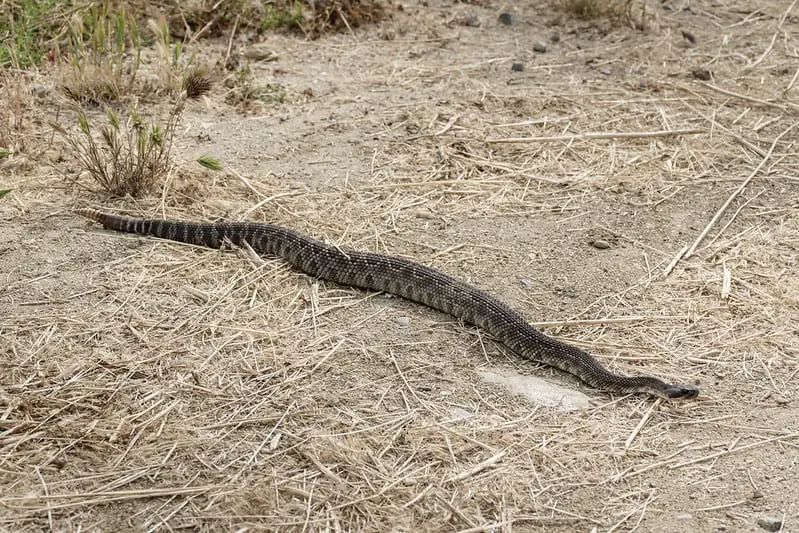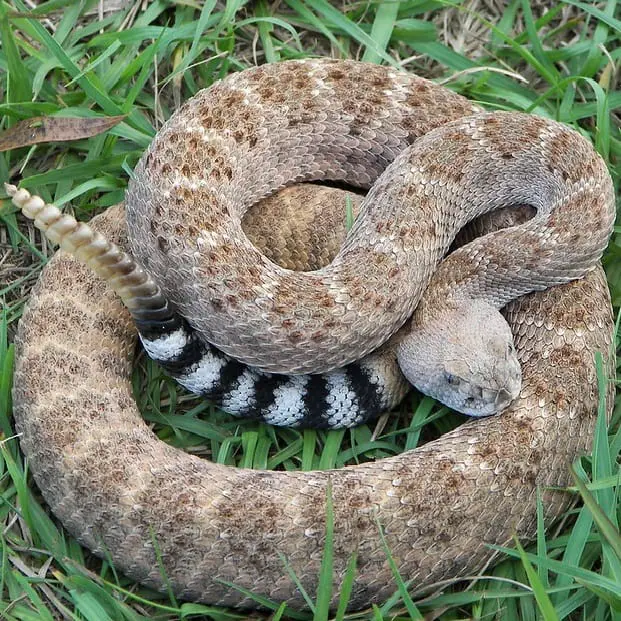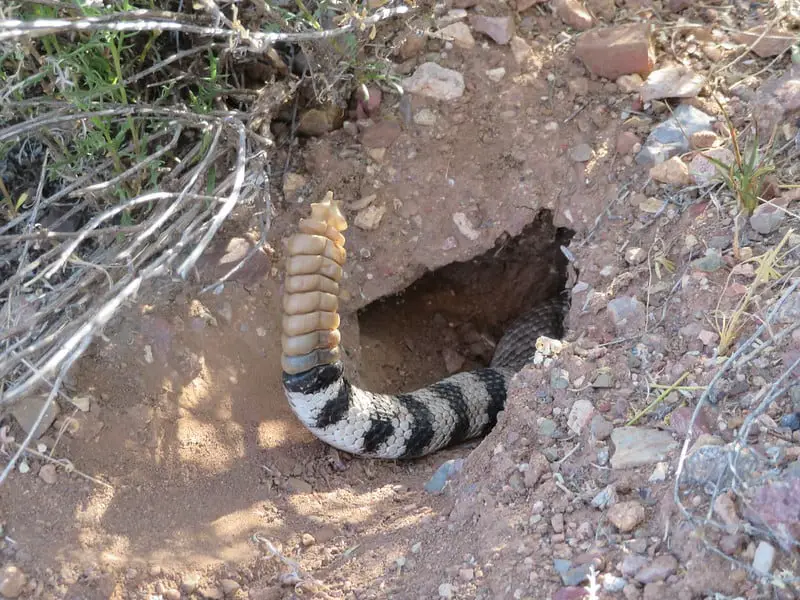Cortalus atrox, commonly called the western diamondback rattlesnake, is a venomous snake found in the Southwestern United States as well as in Northern Mexico. It is one of the most dangerous snakes in the United States and responsible for a large share of snake-related fatalities in the United States (around 5 per year, some of them caused by the western diamondback rattlesnake).
Description
Size
The average length of the western diamondback rattlesnake is around 4 feet (120 cm). The largest ever recorded specimen was found in Cedar Hills, Texas with a length of 7.7 feet (230 cm). Before reaching adulthood, both male and female are about the same size. After reaching sexual maturity, males continue to grow and are generally considerably larger than females once fully grown.
The average weight of the western diamondback rattlesnake is 3 to 6 lb (1.2-2.6 kg). Very large male specimen can reach a weight that is nearly double the average.
The western diamondback rattlesnake is the second largest rattlesnake and venomous snakes that can be found in the United States. It is second to its close relative, the eastern diamondback rattlesnake.

Pattern
The overall body tones of the western diamondback rattlesnake are various shades of brown. The dorsal side of the body is adorned with 23-45 darker brown patterns that are surrounded by a lighter white or grey coloration. The patterns at the end of the body are hexagonal and have a typical diamond-shape. Hence the common name diamondback rattlesnake.
Next to the brown diamond-patterns on its back, the tail is one of the characteristic identification features of the western diamondback rattlesnake. The tail usually has four to six (sometimes only two or up to eight) black bands that are separated by white or light grey colorations. The rattle at the end of the tail is light brown.

Hunting Behavior
The main prey of the western diamondback rattlesnakes are small and medium-sized mammals such as prairie dogs, rats and squirrels. Thanks to its slow and silent movements, it can quietly approach its prey before striking the unsuspecting prey with a fast bite. The venom almost immediately immobilized small mammals.
During the cooler months of spring, the western diamondback rattlesnake is mostly active during the day while it becomes nocturnal during the hot summer months. During the winter months, they are mostly inactive and hibernate or brumate in their burrows.

Bite and Venom
Generally, the western diamondback rattlesnake does not have a very potent venom, compared to other snakes of the viper family. However, due to their large fangs, they are able to inject a large amount of venom with one bite, making it a potentially lethal snake. With one single bite, the snake can inject up to 800 mg of venom that contains various enzymes and toxins that attack blood cells as well as organs.
Effects of a bite are strong local pain, severe swellings, local necrosis (tissue damage), headaches, nausea and other effects. In addition to these symptoms, a strong bite can also lead to internal bleeding that can be fatal in extreme cases. Untreated bites have a mortality rate of up to 20%. If you are bitten by a western diamondback rattlesnake (or something that looked similar), head to the nearest hospital immediately.
Habitat
The western diamondback rattlesnake is a relatively adaptable species and can be found in various habitats. Within its range, the snake can be found in desert areas as well as in forest areas, rocky canyons and grasslands. Most sightings occur on paved roads at nightfall. Since these surfaces retain the heat of the day, snakes come out to heat up their bodies. This also leads to numerous animals losing their lifes through car accidents.
Western diamondback rattlesnake range in the USA
The western diamondback rattlesnake can be found in the Southern States of the United States. It ranges from Southeastern California to Central Arkansas. Namely, it can be found in the following states: Southern Arizona (especeially around Phoenix and Tucson), Arkansas (especially in and around Ouachita National Forest), Southeastern California, Kansas (South of Wichita), Nevada (Southeast of Las Vegas), New Mexico, Oklahoma and Texas (in the West over to Dallas and Houston).
Scientific classification of Crotalus atrox
- Kingdom: Animalia
- Phylum: Chordata
- Class: Reptilia
- Order: Squamata
- Suborder: Serpentes
- Clade: Caenophidia
- Clade: Colubroides
- Family: Viperidae
- Subfamily: Crotalinae
- Genus: Crotalus
- Species: Crotalus atrox
Other common names
Next to its most commonly used name “western diamondback rattlesnake”, Crotalus atrox is also known under the following common names: desert diamond rattlesnake, adobe snake, spitting rattlesnake, Arizona diamond rattlesnake, coon tail, desert diamond-back, fierce rattlesnake, Texas rattlesnake, Texas diamond-back as well as Texas rattler.